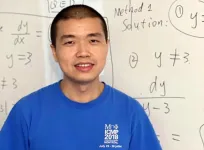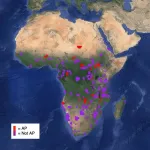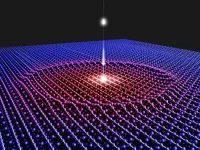(Press-News.org) CAMBRIDGE, MA — It is estimated that about 70 percent of the energy generated worldwide ends up as waste heat.
If scientists could better predict how heat moves through semiconductors and insulators, they could design more efficient power generation systems. However, the thermal properties of materials can be exceedingly difficult to model.
The trouble comes from phonons, which are subatomic particles that carry heat. Some of a material’s thermal properties depend on a measurement called the phonon dispersion relation, which can be incredibly hard to obtain, let alone utilize in the design of a system.
A team of researchers from MIT and elsewhere tackled this challenge by rethinking the problem from the ground up. The result of their work is a new machine-learning framework that can predict phonon dispersion relations up to 1,000 times faster than other AI-based techniques, with comparable or even better accuracy. Compared to more traditional, non-AI-based approaches, it could be 1 million times faster.
This method could help engineers design energy generation systems that produce more power, more efficiently. It could also be used to develop more efficient microelectronics, since managing heat remains a major bottleneck to speeding up electronics.
“Phonons are the culprit for the thermal loss, yet obtaining their properties is notoriously challenging, either computationally or experimentally,” says Mingda Li, associate professor of nuclear science and engineering and senior author of a paper on this technique.
Li is joined on the paper by co-lead authors Ryotaro Okabe, a chemistry graduate student; and Abhijatmedhi Chotrattanapituk, an electrical engineering and computer science graduate student; Tommi Jaakkola, the Thomas Siebel Professor of Electrical Engineering and Computer Science at MIT; as well as others at MIT, Argonne National Laboratory, Harvard University, the University of South Carolina, Emory University, the University of California at Santa Barbara, and Oak Ridge National Laboratory. The research appears in Nature Computational Science.
Predicting phonons
Heat-carrying phonons are tricky to predict because they have an extremely wide frequency range, and the particles interact and travel at different speeds.
A material’s phonon dispersion relation is the relationship between energy and momentum of phonons in its crystal structure. For years, researchers have tried to predict phonon dispersion relations using machine learning, but there are so many high-precision calculations involved that models get bogged down.
“If you have 100 CPUs and a few weeks, you could probably calculate the phonon dispersion relation for one material. The whole community really wants a more efficient way to do this,” says Okabe.
The machine-learning models scientists often use for these calculations are known as graph neural networks (GNN). A GNN converts a material’s atomic structure into a crystal graph comprising multiple nodes, which represent atoms, connected by edges, which represent the interatomic bonding between atoms.
While GNNs work well for calculating many quantities, like magnetization or electrical polarization, they are not flexible enough to efficiently predict an extremely high-dimensional quantity like the phonon dispersion relation. Because phonons can travel around atoms on X, Y, and Z axes, their momentum space is hard to model with a fixed graph structure.
To gain the flexibility they needed, Li and his collaborators devised virtual nodes.
They create what they call a virtual node graph neural network (VGNN) by adding a series of flexible virtual nodes to the fixed crystal structure to represent phonons. The virtual nodes enable the output of the neural network to vary in size, so it is not restricted by the fixed crystal structure.
Virtual nodes are connected to the graph in such a way that they can only receive messages from real nodes. While virtual nodes will be updated as the model updates real nodes during computation, they do not affect the accuracy of the model.
“The way we do this is very efficient in coding. You just generate a few more nodes in your GNN. The physical location doesn’t matter, and the real nodes don’t even know the virtual nodes are there,” says Chotrattanapituk.
Cutting out complexity
Since it has virtual nodes to represent phonons, the VGNN can skip many complex calculations when estimating phonon dispersion relations, which makes the method more efficient than a standard GNN.
The researchers proposed three different versions of VGNNs with increasing complexity. Each can be used to predict phonons directly from a material’s atomic coordinates.
Because their approach has the flexibility to rapidly model high-dimensional properties, they can use it to estimate phonon dispersion relations in alloy systems. These complex combinations of metals and nonmetals are especially challenging for traditional approaches to model.
The researchers also found that VGNNs offered slightly greater accuracy when predicting a material’s heat capacity. In some instances, prediction errors were two orders of magnitude lower with their technique.
A VGNN could be used to calculate phonon dispersion relations for a few thousand materials in just a few seconds with a personal computer, Li says.
This efficiency could enable scientists to search a larger space when seeking materials with certain thermal properties, such as superior thermal storage, energy conversion, or superconductivity.
Moreover, the virtual node technique is not exclusive to phonons, and could also be used to predict challenging optical and magnetic properties.
In the future, the researchers want to refine the technique so virtual nodes have greater sensitivity to capture small changes that can affect phonon structure.
“Researchers got too comfortable using graph nodes to represent atoms, but we can rethink that. Graph nodes can be anything. And virtual nodes are a very generic approach you could use to predict a lot of high-dimensional quantities,” Li says.
###
This work is supported by the U.S. Department of Energy, National Science Foundation, a Mathworks Fellowship, a Sow-Hsin Chen Fellowship, the Harvard Quantum Initiative, and the Oak Ridge National Laboratory.
END
AI method radically speeds predictions of materials’ thermal properties
The approach could help engineers design more efficient energy-conversion systems and faster microelectronic devices, reducing waste heat.
2024-07-26
ELSE PRESS RELEASES FROM THIS DATE:
Study: When allocating scarce resources with AI, randomization can improve fairness
2024-07-26
CAMBRIDGE, MA – Organizations are increasingly utilizing machine-learning models to allocate scarce resources or opportunities. For instance, such models can help companies screen resumes to choose job interview candidates or aid hospitals in ranking kidney transplant patients based on their likelihood of survival.
When deploying a model, users typically strive to ensure its predictions are fair by reducing bias. This often involves techniques like adjusting the features a model uses to make decisions or calibrating the scores it generates.
However, researchers from MIT and Northeastern University argue that these fairness ...
Wencai Liu earns 2024 IUPAP Early Career Scientist Prize in Mathematical Physics
2024-07-26
Dr. Wencai Liu, an associate professor of mathematics at Texas A&M University, has been selected to receive the 2024 International Union of Pure and Applied Physics (IUPAP) Early Career Scientist Prize in Mathematical Physics in recognition of his exceptional achievements and future potential in mathematical physics.
Liu is one of three scientists worldwide honored with the prize, one of 19 celebrating the contributions of early career physicists within the subfields of each commission comprising the IUPAP, which was founded in 1976 to promote research in mathematical physics. Each prize consists of a certificate, medal and a monetary award.
Liu ...
Outsourcing conservation in Africa
2024-07-26
(Santa Barbara, Calif.) — There’s an experiment going on in conservation in Africa. With biodiversity imperiled, and nations facing financial and political crises, some governments are transferring the management of protected areas to private, non-governmental organizations (NGOs).
This strategy seems to be paying off. NGOs can better manage corruption, making them attractive to large donors like the World Bank and European Union. Their capital can fund personnel, research and technology to more effectively manage protected areas and species. While these management changes appear ...
Study finds big disparities in stroke services across the US
2024-07-26
FOR IMMEDIATE RELEASE
Media Contact: Elizabeth.Fernandez@ucsf.edu, (415) 502-6397
Subscribe to UCSF News
Study Finds Big Disparities in Stroke Services Across the U.S.
Low-income communities are up to 42% less likely to obtain stroke center certification.
Hospitals in poor communities are significantly less likely to obtain certification for stroke services, which makes them unable to provide urgent, lifesaving treatment, UC San Francisco researchers are reporting in a 14-year study of the nation’s hospitals.
By ...
Media Tip Sheet: Urban Ecology at #ESA2024
2024-07-26
Interest in urban ecology is growing rapidly as cities expand and the need to understand urban ecosystems becomes more pressing. The Ecological Society of America’s upcoming Annual Meeting in Long Beach, Calif., Aug. 4–9, features a diverse array of talks and posters dedicated to this dynamic field.
Researchers from around the world will present their latest findings on how urban environments impact biodiversity, ecosystem services and human well-being. In addition to a Symposium devoted to the urban ecology of Greater Los Angeles, dozens of talks and posters will offer valuable insights ...
Michigan Plasma prize honors University of Illinois professor
2024-07-26
July 26, 2024
Contact: Kate McAlpine, 734-647-7087, kmca@umich.edu; Nicole Casal Moore, 734-709-1651, ncmoore@umich.edu; Phillip Kisubika, 217-244-7448, pkk18@illinois.edu
Image
ANN ARBOR—He has honed the power of plasma to advance semiconductor processing, high-quality thin films for magnetic hard drives, and fusion energy. For these and other accomplishments, University of Illinois Professor David Neil Ruzic has been chosen to receive the 2024 University of Michigan Prize for Excellence in Plasma Science and Engineering.
Ruzic is the Abel Bliss Professor of Engineering in ...
Atomic 'GPS' elucidates movement during ultrafast material transitions
2024-07-26
UPTON, N.Y. — Scientists from the U.S. Department of Energy’s (DOE) Brookhaven National Laboratory have created the first-ever atomic movies showing how atoms rearrange locally within a quantum material as it transitions from an insulator to a metal. With the help of these movies, the researchers discovered a new material phase that settles a yearslong scientific debate and could facilitate the design of new transitioning materials with commercial applications.
This research, recently published in Nature Materials, marks a methodological achievement; the researchers demonstrated that a materials characterization technique called atomic pair distribution ...
UMBC scientists work to build “wind-up” sensors
2024-07-26
An international team of scientists, including two researchers who now work in the Center for Advanced Sensor Technology (CAST) at UMBC, has shown that twisted carbon nanotubes can store three times more energy per unit mass than advanced lithium-ion batteries. The finding may advance carbon nanotubes as a promising solution for storing energy in devices that need to be lightweight, compact, and safe, such as medical implants and sensors. The research was published recently in the journal Nature Nanotechnology.
Sanjeev Kumar Ujjain, from CAST, was a lead researcher on the work. He started the project while at Shinshu University, in Nagano, Japan, and continued after arriving ...
Researchers receive McKnight award to study the evolution of deadly brain cancer
2024-07-26
Scientist Dr. Aparna Bhaduri, assistant professor of medicine and biological chemistry, and neurosurgeon Dr. Kunal Patel, assistant professor of neurosurgery, both part of the UCLA Health Jonsson Comprehensive Cancer Center, have received the 2024 Neurobiology of Brain Disorders Award from the McKnight Endowment Fund for Neuroscience, which supports innovative research by U.S. scientists who are studying neurological and psychiatric diseases.
The award, $300,000 over the next three years, supports their efforts in gaining a deeper understanding of the microenvironment's role in shaping human glioblastoma, an aggressive type of brain cancer that is fast growing and difficult ...
Heather Dyer selected as the 2024 ESA Regional Policy Award Winner
2024-07-26
The Ecological Society of America (ESA) will present its 17th annual Regional Policy Award to Heather Dyer, Chief Executive Officer of the San Bernardino Valley Municipal Water District, Sunday, Aug. 4, 5:00 p.m. PDT, during the ESA Annual Meeting Opening Plenary. The ESA annual award recognizes an elected or appointed local policymaker whose record reflects the use of ecological science to inform policy decisions.
“ESA is honored to recognize Dyer,” said ESA President Shahid Naeem. “It’s rare for a biologist with ecosystems expertise to transition from technical science work to executive ...
LAST 30 PRESS RELEASES:
Nanoplastics have diet-dependent impacts on digestive system health
Brain neuron death occurs throughout life and increases with age, a natural human protein drug may halt neuron death in Alzheimer’s disease
SPIE and CLP announce the recipients of the 2025 Advanced Photonics Young Innovator Award
Lessons from the Caldor Fire’s Christmas Valley ‘Miracle’
Ant societies rose by trading individual protection for collective power
Research reveals how ancient viral DNA shapes early embryonic development
A molecular gatekeeper that controls protein synthesis
New ‘cloaking device’ concept to shield sensitive tech from magnetic fields
Researchers show impact of mountain building and climate change on alpine biodiversity
Study models the transition from Neanderthals to modern humans in Europe
University of Phoenix College of Doctoral Studies releases white paper on AI-driven skilling to reduce burnout and restore worker autonomy
AIs fail at the game of visual “telephone”
The levers for a sustainable food system
Potential changes in US homelessness by ending federal support for housing first programs
Vulnerability of large language models to prompt injection when providing medical advice
Researchers develop new system for high-energy-density, long-life, multi-electron transfer bromine-based flow batteries
Ending federal support for housing first programs could increase U.S. homelessness by 5% in one year, new JAMA study finds
New research uncovers molecular ‘safety switch’ shielding cancers from immune attack
Bacteria resisting viral infection can still sink carbon to ocean floor
Younger biological age may increase depression risk in older women during COVID-19
Bharat Innovates 2026 National Basecamp Showcases India’s Most Promising Deep-Tech Ventures
Here’s what determines whether your income level rises or falls
SCIE indexation achievement: Celebrate with Space: Science & Technology
Children’s Hospital Colorado performs region’s first pediatric heart and liver dual organ transplant
Australian team discover why quantum computers have memory problems over time
What determines the fate of a T cell?
Candida auris: genetic process revealed which could be treatment target for deadly fungal disease
Groundbreaking discovery turns household plastic recycling into anti-cancer medication
Blocking a key inflammatory pathway improves liver structure and vascular function in cirrhosis, study finds
Continuous spread: Raccoon roundworm detected in nine European countries
[Press-News.org] AI method radically speeds predictions of materials’ thermal propertiesThe approach could help engineers design more efficient energy-conversion systems and faster microelectronic devices, reducing waste heat.



